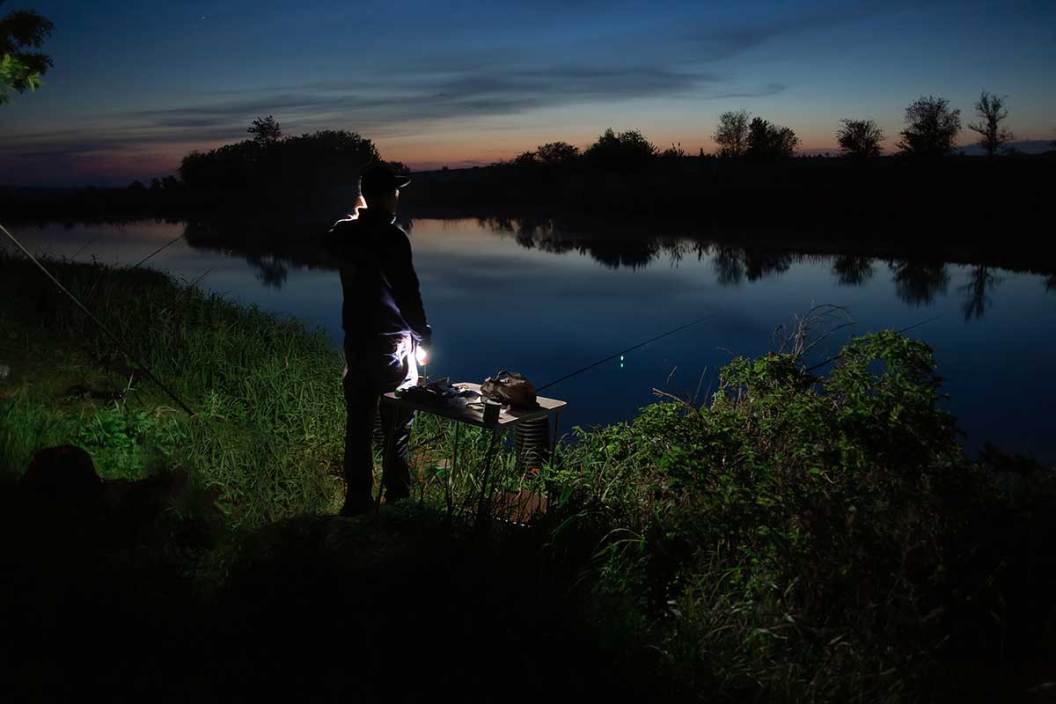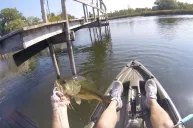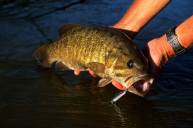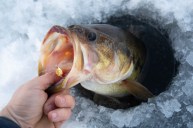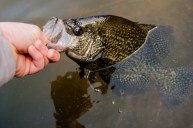These are the generalizations and tips that can help your night fishing experience.
Fishing after dark isn't just a song by the Nitty Gritty Dirt Band.
All kidding aside, we've been fishing after the sun goes down ever since there's been fishing. That first time that we saw a boil on the surface after dark, or just heard a commotion in the distance, we knew quite well that the fish don't go to sleep like we do.
When you factor in the summer heat in the southern part of the United States, night fishing has long since become a great way to try our luck on the water for the shore fishermen in all of us. Over the years, we've managed to find out just what the fish are doing at night, and how to trick them into falling for our best baits, but it's always changing.
The tackle may not be so much different than we use during the daylight hours, but some of the techniques are, in particular the use of stealth. Let's take a look at the baits, locations, and times that work the best when fishing after dark.
One thing you'll want to be sure of is the legalities of night fishing in the location you intend to be. Most public areas or parks have closing times or curfews, and certain water bodies have strict nighttime rules. Be sure you know your rights before attempting to fish at night, and ensure you're doing so properly and ethically.
Here's a small overview of fishing after the sun goes down, followed by some of the species we target along with the tactics involved.
Night Fishing
Fish, as well as any animal, are generally used to using their eyes to locate and attack their prey, so what happens after dark?
Largemouth bass, as you know, have a lateral line down their side which picks up motion, vibration, and even pressure changes, so this feature kicks into overdrive after dark. Knowing this, it behooves the bass fishing enthusiast to keep their bait moving in an effort to make it stick out to a fish.
Then what about the catfish, which often lives in the more turbid and stained waters of North America, day or night? Catfish are a special breed when it comes to the fishes, living everywhere on earth except Antartica, and maybe more amazingly they have astounding sensory abilities.
Maybe no other fish has the taste, touch, smell and hearing of old whisker lips, and yet we have entire pages, forums, and societies based on catching these great tasting fish. Since catfish smell chemical compounds in the water, many fishermen use stink baits to target them, but the fact is that the hearing of catfish is much more acute. They can hear sounds of much higher frequency than other fish such as the largemouth bass, according to Science Direct, they can detect up to about 13,000 cycles per second.
This is why, even at night, anglers must maintain a reasonable amount of stealth and avoid disturbing calmer waters that any of these species reside in because it is not always the sight of an angler that spooks fish, but the sounds that they make.
It also comes to light that the tastes or smells of certain compounds in the water or on your bait can cause feeding to cease. These offending items are in commonly used things such as gasoline, sunscreen, chewing tobacco, and even insect repellent.
When considering doing some night fishing, it means the angler should treat it like ice fishing in one way: safety first. It's one thing when fishing from shore and watching out for your partner when casting (a very important item to consider), but it is quite another when night fishing takes you out onto the water.
On small private ponds or lakes, kayak fishing can be great after dark, but the use of a personal floatation device (PFD) becomes even more critical, especially if you go it alone. You will need to remember some of the most basic gear to have with you such as a headlamp, cell phone or radio (in a proper dry pouch), and a pocket knife or multitool.
And for those preparing to go out on a boat, there are even more things to consider. First off, even if you're going out with more than one person, you need to let some other friends or family know where you will be and for approximately how long. Even in the age of the cell phone, emergencies can happen suddenly and sometimes there isn't much time to respond.
Understand Where You Are
Even those that are fishing an area that they know well don't always do it after dark. Mapping out the area where you will be helps to avoid surprises that are easy to see in the light such as overhanging trees, stumps, rock piles, and even large weed lines that can interfere with a boat motor's operation.
For those of us that have operated a power boat after dark more than once, it is a matter of the law that you will need to have the proper navigation lights, specifically the need to display a red light on the left (port) side of the vessel and a green light displayed on the right (starboard) side. The red and green lights should be visible from at least one mile away on a dark, reasonably clear night.
In fact, in many states, boaters are required by law to take and pass a boating safety course before night travel in a boat can be done.
You should bring along much the same items as previously stated along with extra PFDs, a first aid kit, fire extinguishers, tool kit in the event of a motor breakdown, and even blankets and enough food and water to last until a possible rescue is needed.
You are also better off fine tuning your equipment before you go. In other words, rig your rods ahead of time to avoid doing so in the dark. I have a friend that guides walleye fishing on the St. Lawrence River and while he has every possible safety feature for night fishing on such a large and dangerous body of water, he is adamant that once the fishing begins, only the most necessary and legal lights will be used to keep from spooking these wary nighttime feeders.
Not only that, but consider that the hooks and rigs needed to fish are the same sharp and dangerous items that continually stick our hands and fingers in the daylight when we can see just fine!
It also makes sense that if you are casting for bass, you had better make sure that you don't do it too close to each other because we've all seen what a hook in the face looks like. For pike or muskie fishing after dark: those teeth never seemed as dangerous as when you cannot see them.
Night Fishing Pointers
Probably the three most popular fish to target under cover of darkness are largemouth bass, walleye, and catfish. This is surely not to say that other species of fish cannot be targeted after the daylight hours have gone, just that for various reasons these three have grown in admiration for anglers everywhere due to their ability to provide good action along with some great eating as well.
Bass at Night
Largemouth bass, for instance, are suckers for the same baits that we use during the day such as spinnerbaits, jigs, and topwaters like buzzbaits. But big bass are also great to fish in a more relaxed fashion like using live minnows or with a live craw. At night, when the distractions of the day settle down, these baits can be met with some tackle-busting strikes.
Most of the time bass that have been hanging out off of points, ledges, and deep water humps will come up into the shallower water to feed at night. Now is when you may want to have several rods already rigged with a variety of offerings at the ready. Things like prop baits and buzzbaits are great for creating a commotion, but sometimes the more subtle jitterbug or popper works well to entice a strike at night.
Another great idea is to have a jig-and-pig combo ready when you are getting short strikes on the surface. Pitch or flip these near the area where the fish swirled and hang on. It's even a great idea to use a regular spinnerbait by slow-rolling it just under the surface. Try to create a larger boil, which makes bass go crazy.
Walleye at Night
Walleye are much more famous for they unique ability to see in the low light conditions of darkness. Still, many veteran walleye anglers will tell you that certain moon phases, particularly just before a full moon and in the presence of a new moon, are exceptional times to target marble eyes after dark.
Many river and big water anglers, like my guide friend, will wait until the early morning hours well after midnight and troll stickbaits at various speeds to entice bone-crushing strikes. Along with 8-10 pound walleyes, many of his client photos picture them holding up big, bonus muskellunge that were caught following his walleye setup.
Catfish at Night
As far as catfish go, these are the stuff of legend when it comes to night fishing. It can start with cut bait from the bank and go all the way to live bait fishing for monster flatheads. Catfish are famous for seeking and finding both live bait and artificial lures after dark.
Oily baitfish such as shad are the favorite of catfishermen everywhere, and certain artificials are deadly effective for cats. Night fishing is better largely because summer catfish move from deeper water to the shallows to feed at night, and are easier to find and target.
If you're looking for big blues or flatheads, then you best come prepared. Baitcasting equipment on a good rod and reel combo loaded with an adequate line capacity of at least 200 yards of 17 to 20 pound test and heavy gauge hooks in the 8/0 to 10/0 size are necessities.
The Moonlight Bite
When night falls many creatures of the natural world remain active. It's a totally different experience to fish at night due to lack of light, plus it's more difficult to navigate a boat in the dark. Even the most simple tasks take longer and are more difficult.
That's the bad news.
But there's good news here too. It's much cooler at night during the summer months, the water has calmed down from all of the day's activities, and many times the wind dies down as well. These all promote better fishing conditions.
Catfish, bass, and even walleye feed during all hours, and in some cases are more prone to bite at night than during the day. As with most species of game fish, they feed when the urge strikes them, particularly during changes in the weather and barometer.
Summer nights were made for being outside, and night anglers have been planning fishing trips under the light of the moon for generations. It's well worth trying if you haven't, and seeing how productive it can be.
Products featured on Wide Open Spaces are independently selected by our editorial team. However, when you buy something through our links, we may earn a commission.
Looking for a little more or even hot lunch for your hunting blind? Follow my webpage, or on Facebook and YouTube.
NEXT: PETA WANTS ANGLERS TO "GO VEGAN" BECAUSE HARASSING, KILLING, AND EATING FISH IS "SO CRUEL"
WATCH
